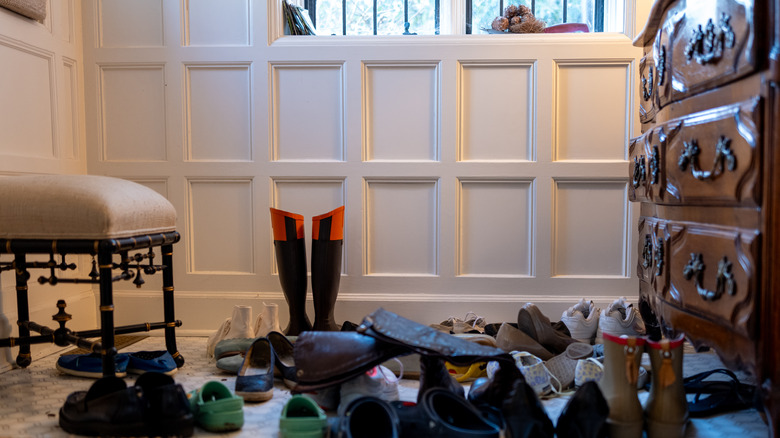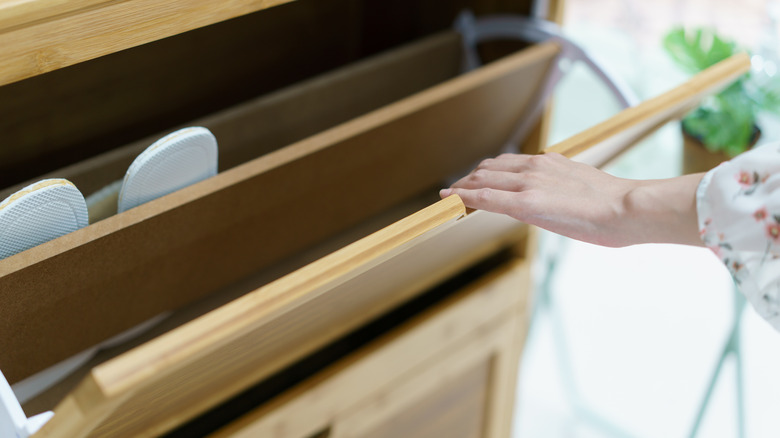How To Pick The Right Shoe Cabinet For Your Footwear
We may receive a commission on purchases made from links.
Go on, admit it. Your shoe organization system is ruining your aesthetic. That ten-year-old shoe rack really doesn't fit comfortably into the entryway of your new apartment, does it? Maybe you don't store your footwear fancy at all, preferring to toss them into the closest corner as you walk in the door. It's time for a change. And that involves purchasing a shoe cabinet that slots nicely into wherever you need it, matches your decor, and keeps your clodhoppers dust- and moisture-free. It also needs to fit, not bust the seams of, the line item on your budget earmarked for home upgrades and maybe have a few flashy features, like a seat, mirror, or built-in deodorizing technology.
"You want to be able to keep pairs together so you can find the shoes you need when you want them, " says certified Professional Organizer Jean Prominski at Seattle Sparkle (via Nike). Sure, but how is a shoe cabinet that does this different from other shoe storage solutions? Compared with shoe racks or shelves, shoe cabinets have the advantage of discretion. Close-able doors hide your shoes away and lock the inevitable foot smells in. They're also not uniform in design — they come slim-line or wall-mounted, are made of metal or hardwood, and have standard shelves or tilt-out drawers. Here's how to choose a cabinet over other shoe-organization options if you need storage for an open space, like an entryway or bedroom (in the room itself), rather than for in-closet organization.
Size matters most when choosing a shoe cabinet
Before you do any shopping, take stock of your shoe collection. First, go through your shoes and discard any you no longer wear or that are worn out. Count how many shoes remain. A medium-sized shoe cabinet, measuring 24 inches wide and 36 inches tall, will fit 20 or so pairs of adult shoes. You want to ensure the cabinet you buy is big enough for each pair to have its own spot; piling up shoes damages them. Note your kicks styles, sizes, and which season they're for. Do you need tall vertical space for boots? Will your winter shoes be in storage during summer, or will they stay in the cabinet all year round?
Entryways and foyers are logical spots for shoe cabinets, especially if you're a shoes-off-inside family, but they lack elbow room. Slim-line cabinets with flip-out drawers are a great solution here. The classic IKEA TRONES plastic shoe cabinet in black costs less than $40 for a 2-pack, and you can add more drawers as needed. Alternatively, going for under $120 at Walmart, you can stop saving bulky shoeboxes when you could be storing shoes in HSUNNS' 20-pair free-standing shoe storage rack in white. It has a wide catch-all area on top for dumping keys and pocket change. When the location is decided, get out your tape measure and commit the maximum dimensions of your cabinet to paper (or the notes app on your smartphone) before your shopping trip.
Consider the materials, price, and special features before you buy a shoe cabinet
When authors of a 2023 RMTB-published paper surveyed a select group of Malaysian consumers on shoe cabinet preferences, natural timber was the material of choice. You can expect to pay higher prices for real lumber. For example, West Elm's 36-inch wide Anton solid mango wood shoe cabinet goes for a cool $1,299. Don't discount less traditional materials like plastic or metal. This Novogratz two-door cabinet crafted from lemon yellow-painted metal — going for just under $175 from Bed Bath & Beyond — gives total vintage vibes and will handle rough treatment.
Shoe cabinets made from composite wood products are more affordable (though often not as long-lasting). A Lookebill MDF shoe storage bench will set you back just under $90 at Wayfair. Your preferred style can dictate the material, too. This undeniably attractive mid-century modern shoe cabinet by MoNiBloom ($90 at Walmart) is crafted from period-appropriate bamboo and rattan. As you can see, prices vary wildly; work out your maximum spend before you shop.
Don't get too bogged down in the special features, either. The goal is to find an easy shoe storage solution for your entryway that's both stylish and smart. Useful add-ons include ventilation to prevent moisture, stinks, and mold build-up, as well as flexible shelving, bench seats, and mirrors. Have a shoe collection worthy of display? Get a cabinet with glass doors! Need to squeeze lots of shoes into a small space? Choose a rotating shoe cabinet.


